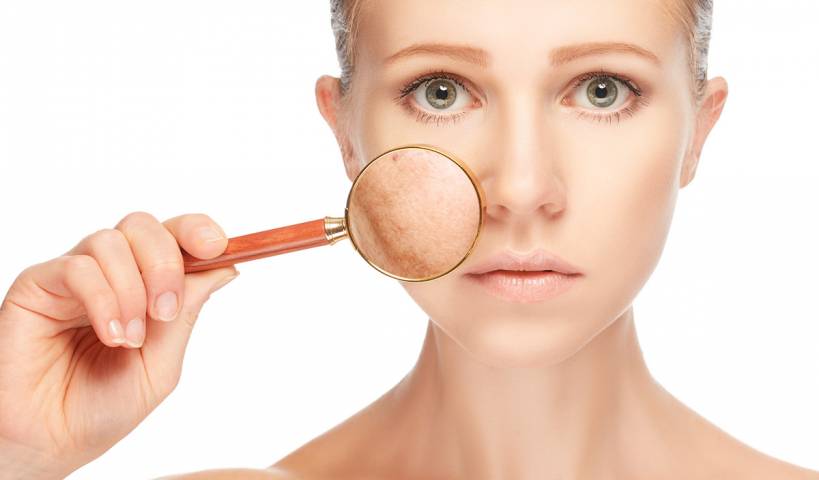Studies show that there are two different types of aging. Aging caused by our genetics is called intrinsic, or internal, aging. The second type of aging is called extrinsic, or external, aging and is brought on by factors related to the environment.
Intrinsic Aging
Intrinsic aging is your body’s natural aging process, and typically starts in your mid 20’s. Inside your skin, production of collagen and elastin decreases. Your skin does not shed dead skin cells as quickly and the formation of new skin cells slows somewhat. These changes are usually not noticeable for decades. Intrinsic aging signs are:
• Fine lines
• Skin that is thin and opaque
• Underlying fat loss, resulting in sucked in cheeks and eye sockets, and loss of elasticity in neck and hands
• Bone loss resulting in bone shrinkage from your skin, causing it to sag
• Dry, itchy skin
• Loss of ability to sweat enough to cool the skin
• Hair that is greying and ultimately turns white
• Loss of hair
• Thinning, hardened nail beds
Your genetics are a huge factor in how quickly the aging process begins to occur. Some people may begin to see grey hair in their 20’s; others may not notice greys until their 40’s.
Extrinsic Aging
Many extrinsic, otherwise known as external, factors coupled with the body’s natural aging process can result in premature aging. Sun exposure is the main cause of premature aging. Additional extrinsic factors that may cause premature skin aging include smoking, habitual facial expressions, gravity, and repetitive sleeping positions.
Sun Damage
By not protecting yourself from the sun while outdoors, even a few minutes of sun exposure a day can noticeably affect your skin over the years. Wrinkles and fine lines, freckles, leathery or rough skin, age spots, loose skin, spider veins, mottled or blotchy skin colouring, and skin cancer are all risks of unprotected exposure to the sun. Dermatologists use the term “Photoaging” for this type of sun-related aging. The degree of photoaging that occurs depends on an individual’s skin colour and the amount of sun exposure they’ve incurred. Fair-skinned individuals with prolonged sun exposure are more prone to developing photoaging than individuals with darker skin.
Prolonged sun exposure causes the skin to lose its ability to repair itself and causes severe damage over the years. Skin weakened from the sun fails to heal itself much sooner than skin that has not had prolonged UV exposure.
Facial Expressions
If facial exercises are something you do to keep looking youthful, stop them immediately. Fine lines and wrinkles are actually caused by repetitive facial movements. Every time a facial muscle is used, a tiny groove is formed under your skin’s surface. As you age and your skin’s elasticity decreases, your skin does not bounce back to its original state, and the grooves created become permanent wrinkles and fine lines on your face.
Gravity’s Effect
The gravitational pull on our bodies becomes more evident as we grow older, especially when our skin’s elasticity severely decreases in our 50’s. Gravity is the cause of a drooping nose tip, elongated ears, drooping eyelids and jowls, and a thinner upper lip and more pronounced lower lip.
Sleeping Positions
Sleeping in the same position on your face for years on end can create wrinkles. These are called sleep lines and become permanently engraved on the skin after time. Women are more prone to see these lines on their cheeks and chins, since they usually sleep on their sides. Men usually see them on their foreheads, from sleeping face down.
Cigarette Smoking
Smoking dramatically speeds up the aging process, and studies show that someone who smokes more than 10 cigarettes per day for 10 years or longer is far likelier to have deep wrinkles and leathery skin than a person who is a non-smoker. A yellowish skin hue is also something smokers are likely to develop after a number of years. Even heavy smokers or people who smoked when they were young can lessen facial wrinkling and improve their skin colour after quitting smoking.
Skin Damage Prevention
While the intrinsic aging process cannot be stopped or slowed down, premature aging can be prevented by taking precautionary measures in the sun, by quitting smoking, and by not practicing facial exercises. It is recommended by dermatologists that complete sun protection methods are followed to avoid sun damage. These methods includes:
- Not deliberately sun tanning, including the use of a tanning bed.
- Avoiding direct sun between the hours of 10am and 4pm, when the sun is at its harshest.
- Wearing protective clothing like hats that cover the face and long sleeves while out in the sun.
- Applying sunscreen at all times. Your sunscreen should have UVA and UVB protection, and have a minimum of SPF 30. You should apply sunscreen 20 minutes prior to going outside and reapply it if you are sweating or have gone in the water.





